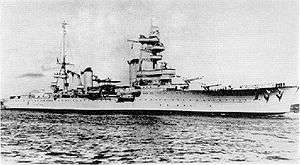French cruiser Foch
Foch was a French Navy heavy cruiser of the Suffren class, that saw service in World War II. She was the first French warship named for the French Marshal Ferdinand Foch.
 Foch | |
| History | |
|---|---|
| Name: | Foch |
| Namesake: | Ferdinand Foch |
| Builder: | Arsenal de Brest |
| Laid down: | 21 June 1928 |
| Launched: | 24 April 1929 |
| Commissioned: | 15 August 1931 |
| Fate: | scuttled at Toulon, 27 November 1942, scrapped 1943-44 |
| General characteristics | |
| Class and type: | Suffren-class cruiser |
| Displacement: |
|
| Length: | 196 m (643.04 ft) |
| Beam: | 20 m (65.62 ft) |
| Draught: | 7.3 m (23.95 ft) |
| Propulsion: | 3-shaft Rateau-Bretagne SR geared turbines, 9 Guyot boilers, 100,000 shp (75,000 kW) |
| Speed: | 32 knots (59 km/h; 37 mph) |
| Range: | 4,500 nautical miles (8,300 km; 5,200 mi) at 15 knots (28 km/h; 17 mph) |
| Complement: | 773 |
| Armament: |
|
| Armour: |
|
| Aircraft carried: | 2 Loire-Nieuport 130 |
| Aviation facilities: | 2 catapults |
Design and description
The design of the Suffren class was derived from the preceding Duquesne class with more armor exchanged for less speed. The ships had an overall length of 194 meters (636 ft 6 in), a beam of 19.26 meters (63 ft 2 in), and a draft of 6.57 meters (21 ft 7 in). They displaced 10,160 metric tons (10,000 long tons) at standard load and 13,135–13,644 t (12,928–13,429 long tons) at deep load. Their crew normally consisted of 647 men and increased by 84 when serving as flagships.[1]
Service history
In the early part of World War II, Foch and her sister, Dupleix, formed Force M, based at Dakar.
On 14 June 1940, during World War II, the French 1st Cruiser Division comprising the cruisers Algérie and Foch and escorting destroyers bombarded Vado near Genoa, Italy.
After France surrendered to Germany in June 1940, Foch served with the navy of Vichy France. Foch was among the ships scuttled during the scuttling of the French fleet in Toulon on 27 November 1942 . The ship was scuttled with open sea valves, plus charges to her main armament, to prevent her capture by the Germans. However, the ship was relatively undamaged and repair (possibly as an aircraft carrier) was contemplated by the Italians, who refloated her on 16 April 1943. She was instead towed to La Seyne where she was broken up during 1943-1944.
References
- Jordan & Moulin, pp. 50, 71–72
Bibliography
- Jordan, John & Moulin, Jean (2013). French Cruisers 1922–1956. Barnsley, UK: Seaforth Publishing. ISBN 978-1-84832-133-5.
- Saibène, Marc (n.d.). Toulon et la Marine 1942–1944. Bourg en Bresse: Marines Editions at Realisations.